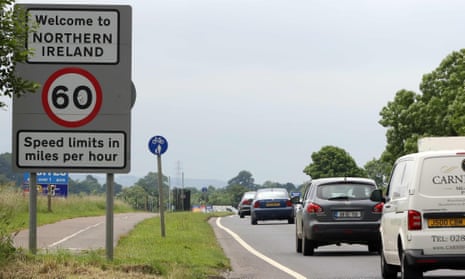The scale of the difficulties facing Brexit negotiators in disentangling the border between Britain and Ireland has been highlighted by new data showing there were more than 110m border crossings between the two last year.
An official analysis by British and Irish statisticians found there were an estimated 375,900 Irish-born people living in the UK and 277,200 UK-born people living in Ireland.
The scale of possible disruption through the introduction of a post-Brexit hard border between Northern Ireland and Ireland is underlined by the estimate that, in May this year at selected crossing points, there were 118,000 private vehicle crossings on a daily basis, which extrapolates to 43m crossings annually at those sites alone. At the same sites there are also an estimated 900,000 cross-border coach passenger journeys every year and 868,500 cross-border train passenger journeys.
The report published on Thursday adds that, according to the 2016 Irish census, there were 57,000 residents of Ireland who were born in Northern Ireland and, according to the 2011 Northern Ireland census, 38,000 residents of Northern Ireland who were born in Ireland. The five district councils closest to the border in Northern Ireland have 23,000 (61%) Northern Ireland residents who were born south of the border.
The detailed statistical portrait of the Irish-born living in Britain shows an ageing population of first-generation migrants, with 42% over the age of 65. Among those of working age, more than one in three work in professional occupations, including teaching, nursing and the tech industries.
The profile of the UK-born population in Ireland is younger, with 134,840 (31%) in receipt of a UK state pension. The occupational sector with the highest proportion of UK-born people is culture, media and sport, where they are one in eight of the workforce.
The report also contains a breakdown of the latest migration figures for Northern Ireland, which shows that, in addition to 38,000 Irish-born residents, there are 25,000 Poles, 25,000 Lithuanians and 28,000 residents who were born in other EU countries. Many can expect to be asked to apply for the new “settled status” when Britain leaves the EU. There are a further 45,000 people who were born outside the EU living in Northern Ireland.
Emma Rourke, director of public policy analysis at the Office for National Statistics, said: “The complex and historic relationship between the UK and Ireland is one of the most challenging areas facing the UK and the EU as Brexit negotiations proceed.
“The sort of analysis we have published today with our colleagues in the Irish and Northern Ireland statistical agencies is going to be indispensable as these negotiations develop. It will be more important than ever to have clear and comprehensive data on how and where citizens of our two countries are living and working across borders.”
